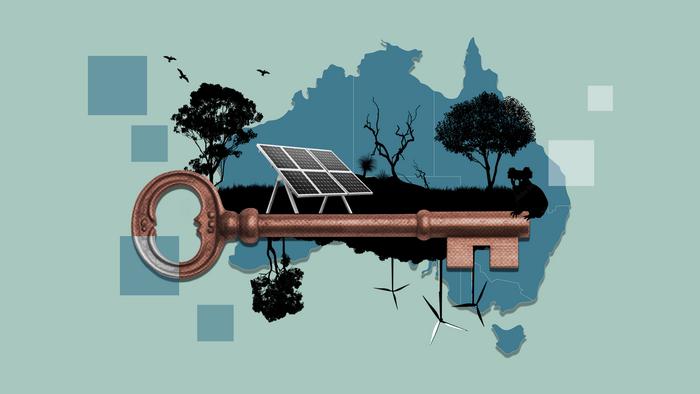In a groundbreaking study published in Nature Sustainability, researchers from Princeton University and The University of Queensland have illuminated a pragmatic path toward the full decarbonization of Australia’s domestic and energy export economies by 2060. The study goes beyond conventional technical modeling by integrating the diverse perspectives of stakeholders such as energy developers, governments, Indigenous groups, farmers, and conservationists—a critical advance in ensuring that net-zero ambitions do not come at the expense of biodiversity, agricultural productivity, or Indigenous land rights.
Transitioning an economy as vast and resource-dependent as Australia’s to net-zero greenhouse gas emissions is an enormous challenge, not least because of the sheer scale of renewable energy infrastructure required. The team’s research reveals that meeting these targets would demand approximately 110,000 square kilometers of renewable energy development—an area roughly 1.7 times the size of Tasmania. However, what sets this study apart is its fusion of high-resolution technoeconomic modeling with nuanced land-use constraints informed by key stakeholder values, maximizing efficiency while safeguarding natural and cultural assets.
Andrew Pascale, lead author and research scholar at Princeton’s Andlinger Center for Energy and the Environment, emphasized the urgency and scale of the endeavor: “The land requirement for this energy transition is unprecedented, and the pace at which infrastructure must be deployed is faster than any prior energy rollout in history.” Yet, Pascale and colleagues demonstrate that achieving net-zero can be done responsibly by carefully selecting site locations in collaboration with stakeholders, ensuring that renewable infrastructure coexists harmoniously with biodiversity hotspots, agricultural lands, and Indigenous estates.
The researchers developed a novel ‘traffic-light’ system for siting renewable energy projects. Zones marked green are ideal for development, orange zones require further stakeholder engagement to resolve potential conflicts, and red zones are designated off-limits due to their ecological or cultural importance. This approach reflects an adaptive, participatory planning methodology that balances climate goals with the preservation of natural capital, an aspect often overlooked in traditional energy transition models.
Crucially, if stakeholders fail to negotiate compromises on land use, the study warns, Australia risks an energy shortfall of nearly 500 gigawatts alongside higher electricity costs, jeopardizing the pathway to net-zero. This envisaged clean energy deficit could force reliance on more expensive or environmentally damaging alternatives. Co-author Chris Greig, senior research scientist at the Andlinger Center, underscored the complexity of these competing priorities, noting, “Protecting biodiversity, respecting Indigenous estates, and supporting farmers must be integrated alongside climate imperatives to avoid unacceptable trade-offs.”
The research builds directly on prior multi-institutional efforts under the Net Zero Australia initiative, a comprehensive mapping of potential decarbonization trajectories aimed at preserving the country’s $6.2 trillion economy. By consulting with groups such as the National Farmers Federation, the National Native Title Council, and the Australian Conservation Foundation, the team infused real-world perspectives into their computational simulations, creating a more holistic and implementable strategy.
James Watson, a professor of environmental management at The University of Queensland, highlighted the novelty of their integrated approach: “This is among the first works to embed biodiversity and natural capital considerations explicitly into energy infrastructure planning at a national scale.” He stressed that such integrative modeling is pivotal to reconcile environmental stewardship with the rapid expansion of renewable energy necessary to curb climate change impacts.
Their findings also critically evaluate existing Australian Energy Regulator renewable energy zones, exposing that over 90% of some designated areas overlap with regions critical for biodiversity protection. This revelation points to a disconnect between current regulatory zones and ecological priorities, prompting calls for a reevaluation of planning strategies to minimize environmental conflicts proactively.
Underlying the entire study is a call for flexibility and ongoing stakeholder engagement. The researchers acknowledge inherent uncertainties, such as incomplete habitat data and the unpredictable impacts of climate change on species distribution, necessitating regular updates to modeling and planning frameworks. This dynamic, iterative approach contrasts with static, top-down models that risk locking in suboptimal or damaging land-use decisions.
Despite these scientific challenges, Watson emphasized the imperative to act immediately with the best available data. “Waiting for perfect information should not paralyze progress,” he remarked. “Protecting existing endangered habitats while strategically siting renewable projects is both urgent and achievable.” This pragmatic stance balances caution with the urgency of climate action and land conservation.
In sum, this study sends a clear message: the quest for a clean energy future in Australia must embrace complexity, respect diverse societal goals, and foster collaboration. By marrying rigorous computational modeling with stakeholder values, the researchers present a scalable blueprint for how nations can navigate the intricate and often contested pathways to net zero, ensuring that ambitious climate goals coexist with enduring social and ecological wellbeing.
As Australia prepares to expand its renewable energy portfolio substantially, this research underscores that success hinges not only on technology and capital but on the willingness of all parties to negotiate, adapt, and share a vision for a sustainable and equitable future. The proposed planning framework offers a replicable model for other countries wrestling with similar multifaceted challenges amid their own energy transitions.
Subject of Research: Not applicable
Article Title: Negotiating risks to natural capital in net-zero transitions
News Publication Date: 29-May-2025
Web References:
https://www.nature.com/articles/s41893-025-01576-y
https://www.netzeroaustralia.net.au/
https://nff.org.au/
https://nntc.com.au/
https://www.acf.org.au/
References:
Pascale, A., Greig, C., Watson, J., et al. (2025). Negotiating risks to natural capital in net-zero transitions. Nature Sustainability. https://doi.org/10.1038/s41893-025-01576-y
Image Credits:
Bumper DeJesus / Andlinger Center for Energy and the Environment
Keywords:
Net-zero, Australia, decarbonization, renewable energy infrastructure, biodiversity, Indigenous land rights, energy modeling, sustainable development, land use planning, energy transition, natural capital, stakeholder engagement




